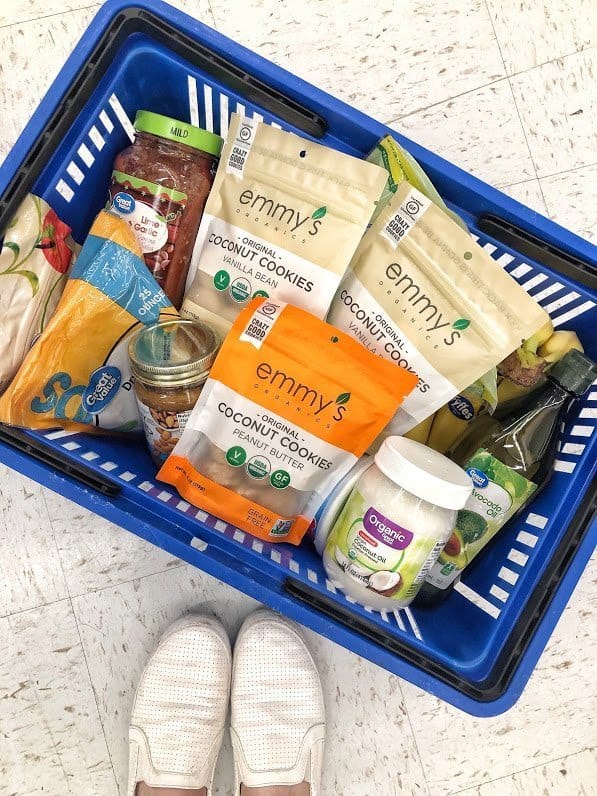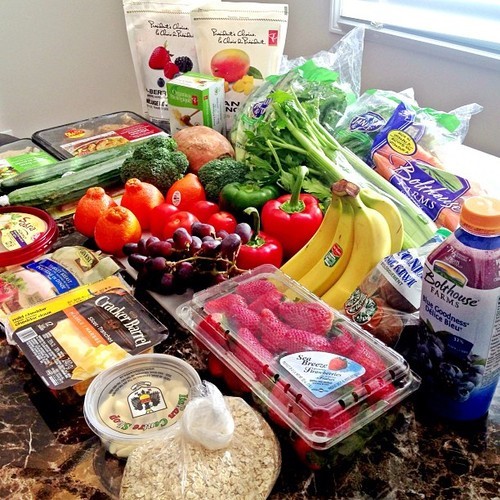What to Buy for Healthy Eating, buy fresh fruits, vegetables, lean proteins, and whole grains. Avoid processed foods and sugary drinks.
Maintaining a healthy diet is crucial for overall well-being. Opt for nutrient-dense foods that provide essential vitamins and minerals. Fresh fruits and vegetables offer fiber and antioxidants. Lean proteins, such as chicken, fish, and legumes, support muscle health. Whole grains, like brown rice and quinoa, provide sustained energy.
Steer clear of processed foods, which often contain unhealthy fats and added sugars. Choosing these wholesome foods can improve your energy levels and reduce the risk of chronic diseases. Make informed choices to support a balanced diet and enhance your quality of life. Healthy eating doesn’t have to be complicated; focus on natural, unprocessed options.

Credit: jennawaters.com
The Importance Of A Well-stocked Pantry
A well-stocked pantry is essential for maintaining a healthy diet. Having the right foods at hand makes it easier to prepare nutritious meals. You can avoid unhealthy choices when you have healthy options readily available.
Key Benefits
Stocking your pantry with healthy foods offers many advantages:
- Convenience: Quick access to ingredients saves time.
- Cost-Effective: Bulk buying reduces grocery expenses.
- Prevents Waste: Proper storage keeps food fresh longer.
- Variety: Ensures you have diverse meal options.
Impact On Daily Nutrition
A well-stocked pantry improves your daily nutrition by providing easy access to healthy foods. Here are some items to include:
| Category | Examples |
|---|---|
| Whole Grains | Brown rice, quinoa, oats |
| Proteins | Canned beans, nuts, seeds |
| Healthy Fats | Olive oil, avocado oil |
| Spices & Herbs | Turmeric, basil, oregano |
Including these items ensures you get a balanced diet. It helps you avoid processed and unhealthy foods. Fresh fruits and vegetables should also be part of your diet. They provide essential vitamins and minerals.

Credit: www.erinliveswhole.com
Whole Grains: The Foundation
What to Buy for Healthy Eating? Whole grains form a crucial part of a balanced diet. They are packed with essential nutrients and provide a great source of energy. Incorporating whole grains into your diet can improve your health significantly.
Types To Keep On Hand
Having a variety of whole grains in your pantry is essential. Here are some types you should consider:
- Brown Rice: A staple in many households. It’s versatile and nutritious.
- Quinoa: High in protein and gluten-free.
- Oats: Perfect for breakfast and baking.
- Barley: Great for soups and stews.
- Bulgur: Quick-cooking and ideal for salads.
Creative Uses In Meals
Incorporating whole grains into meals can be easy and fun. Here are some creative ideas:
- Brown Rice: Use it as a base for stir-fries or grain bowls.
- Quinoa: Mix it into salads or use it as a stuffing for vegetables.
- Oats: Make overnight oats or add to smoothies for extra fiber.
- Barley: Add to soups or use in risottos for a chewy texture.
- Bulgur: Combine with fresh herbs and vegetables for a quick tabbouleh.
Whole grains are not just healthy; they are also incredibly versatile. Keep a variety in your pantry to ensure a nutritious and delicious diet.
Proteins: Plant-based And Beyond
What to Buy for Healthy Eating? Proteins are essential for a healthy diet. They help build muscle and repair tissue. Plant-based proteins are great for a healthy lifestyle. These proteins can be found in many foods. Learn what to buy for healthy eating with these tips.
Essential Pantry Proteins
Stock your pantry with these proteins:
- Beans: Black beans, chickpeas, and lentils are rich in protein.
- Nuts and seeds: Almonds, chia seeds, and sunflower seeds offer healthy fats and protein.
- Quinoa: This grain is a complete protein.
- Tofu and tempeh: These soy products are versatile and protein-packed.
A well-stocked pantry makes meal prep easier. You can mix and match these proteins in various dishes.
Incorporating Proteins Into Dishes
Adding proteins to your meals is simple. Here are some easy ideas:
- Salads: Top salads with chickpeas or grilled tofu.
- Stir-fries: Add tempeh or edamame to your favorite stir-fry recipe.
- Breakfast: Mix chia seeds into smoothies or oatmeal.
- Soups: Include lentils or beans for a protein boost.
These proteins enhance your meals and keep you full longer. Experiment with different combinations to find your favorites.
Healthy Fats: Oils And Nuts
Healthy fats are crucial for a balanced diet. They support brain function and help absorb vitamins. Two excellent sources of healthy fats are oils and nuts. Let’s explore how to choose the best options for your diet.
Selecting Quality Oils
Choosing the right oils can make a big difference. Here are some top choices:
- Extra Virgin Olive Oil: Rich in antioxidants and great for salads.
- Avocado Oil: High in monounsaturated fats, perfect for cooking.
- Coconut Oil: Good for baking and has a unique flavor.
- Flaxseed Oil: Packed with omega-3s, ideal for cold dishes.
Check labels for cold-pressed and organic options. Avoid oils with trans fats. Always store oils in a cool, dark place.
Nuts And Seeds For Snacking And Cooking
Nuts and seeds are versatile and nutritious. They can be used in many dishes or as snacks. Here are some healthy options:
| Nut/Seed | Benefits | Uses |
|---|---|---|
| Almonds | Rich in vitamin E and fiber | Snacks, salads, baking |
| Walnuts | High in omega-3 fatty acids | Granola, oatmeal, salads |
| Chia Seeds | Excellent source of omega-3s and protein | Smoothies, puddings, baking |
| Pumpkin Seeds | Loaded with magnesium and zinc | Trail mix, soups, salads |
Choose unsalted and raw options for the healthiest choice. Store nuts in airtight containers to keep them fresh. Eating a handful of nuts daily can boost your health. Try adding seeds to your meals for extra nutrients.
Spices And Herbs: Flavor Without The Calories
What to Buy for Healthy Eating? Spices and herbs can transform any dish. They add flavor without adding extra calories. Eating healthy doesn’t mean eating bland food. The right spices and herbs make all the difference.
Must-have Spices For Any Pantry
Stocking your pantry with essential spices is key. Here are some must-haves:
- Cinnamon: Great for both sweet and savory dishes.
- Turmeric: Known for its anti-inflammatory properties.
- Garlic Powder: Adds a burst of flavor to any dish.
- Chili Powder: Perfect for adding heat.
- Cumin: Essential for Mexican and Indian cuisines.
Growing Your Own Herbs
Growing your own herbs ensures freshness. It also saves money. Here are some easy herbs to start with:
- Basil: Great for Italian dishes and salads.
- Mint: Perfect for teas and desserts.
- Parsley: A versatile herb for many dishes.
- Rosemary: Adds a robust flavor to meats and vegetables.
- Thyme: Ideal for soups and stews.
| Herb | Best Use |
|---|---|
| Basil | Italian dishes, salads |
| Mint | Teas, desserts |
| Parsley | Various dishes |
| Rosemary | Meats, vegetables |
| Thyme | Soups, stews |
Canned And Jarred Goods: Convenience Meets Nutrition
What to Buy for Healthy Eating? Canned and jarred goods offer a blend of convenience and nutrition. These items are shelf-stable and easy to store. They help busy individuals maintain a healthy diet. Many options are available that are both tasty and nutritious.
Choosing Wisely
Not all canned and jarred goods are created equal. Some contain high levels of sodium or added sugars. To make healthy choices, read labels carefully.
- Low-sodium options: Choose canned vegetables and beans labeled “low sodium” or “no salt added.”
- No added sugars: Look for fruits packed in water or their own juice, not syrup.
- Natural ingredients: Aim for products with minimal ingredients, avoiding artificial preservatives.
Storage Tips
Proper storage extends the shelf life of canned and jarred goods. Keep them in a cool, dry place. Avoid storing in direct sunlight or near heat sources.
| Item | Storage Tips |
|---|---|
| Canned Vegetables | Store in a dark, cool pantry. Use within one year. |
| Jarred Sauces | Refrigerate after opening. Use within two weeks. |
| Canned Fish | Keep in a cool pantry. Use within two years. |
Always check the expiration date before consuming. Once opened, transfer any leftovers to airtight containers. Refrigerate and use them quickly.
Snacks: Healthy Options For Cravings
Cravings can hit anytime. Having healthy snacks helps you stay on track. Choosing the right snacks is key to maintaining good health. Let’s explore how to make smart choices.
Choosing Satisfying, Nutritious Snacks
Pick snacks that are both filling and nutritious. Protein-rich foods like nuts and seeds are great. Fruits and vegetables provide essential vitamins and minerals. Whole grains offer fiber to keep you full longer.
Here are some healthy snack ideas:
- Almonds and walnuts
- Apple slices with peanut butter
- Carrot sticks with hummus
- Greek yogurt with berries
- Whole grain crackers with cheese
Avoiding Common Pitfalls
Some snacks might seem healthy but aren’t. Avoid snacks with high sugar or salt content. Check labels for hidden sugars and unhealthy fats.
Here are some tips to avoid common pitfalls:
- Read nutrition labels carefully
- Avoid snacks with added sugars
- Choose snacks with less than 200 calories
- Opt for snacks with high fiber
- Avoid processed foods
| Healthy Snacks | Unhealthy Snacks |
|---|---|
| Fresh fruit | Fruit snacks |
| Nuts and seeds | Potato chips |
| Vegetable sticks | Fried snacks |
| Greek yogurt | Ice cream |
Beverages: Staying Hydrated The Right Way
What to Buy for Healthy Eating? Healthy eating isn’t just about food. It’s also about what you drink. The right beverages can help you stay healthy and energized. Let’s explore some great options for staying hydrated the right way.
Water And Other Healthy Drinks
Water is the best drink for your body. It keeps you hydrated and has no calories. Drinking water helps your body function well and keeps your skin looking great.
You can also try other healthy drinks:
- Herbal teas: These are caffeine-free and come in many flavors.
- Coconut water: It’s a natural drink with electrolytes.
- Infused water: Add fruits or veggies to your water for flavor.
These drinks provide hydration and health benefits without added sugars.
Limiting Sugary And Caffeinated Beverages
Sugary drinks can be tempting but are not good for you. They can lead to weight gain and other health problems.
Here are some drinks to limit:
- Sodas: High in sugar and offer no nutritional value.
- Energy drinks: Often high in caffeine and sugar.
- Sweetened teas: They may have more sugar than you think.
Caffeinated drinks can also cause issues if consumed in large amounts. Too much caffeine can lead to sleep problems and jitteriness.
Try to choose drinks that are low in sugar and caffeine. Your body will thank you!
:max_bytes(150000):strip_icc()/The-Top-10-Healthy-Foods-to-Always-Have-On-Your-Grocery-List-GettyImages-1217813819-1-2000-640061f907b44972b9ffda01201d72b5.jpg)
Credit: www.shape.com
Frequently Asked Questions
What Food Should I Buy To Eat Healthy?
Buy fresh fruits, vegetables, lean meats, whole grains, nuts, seeds, and low-fat dairy. Choose organic when possible. Avoid processed foods.
What Is A Healthy Grocery List Of Foods?
A healthy grocery list includes fresh fruits, vegetables, lean proteins, whole grains, nuts, seeds, and low-fat dairy products.
What Are The Top 10 Healthy Foods?
The top 10 healthy foods include salmon, blueberries, spinach, nuts, quinoa, Greek yogurt, broccoli, sweet potatoes, avocados, and eggs.
What Are The 7 Types Of Food You Need To Eat To Stay Healthy?
The 7 types of food for a healthy diet include fruits, vegetables, whole grains, lean proteins, dairy, nuts, and seeds.
Conclusion
Choosing the right foods can transform your health. Focus on fresh produce, lean proteins, and whole grains. Prioritize organic options when possible. Remember, healthy eating starts with smart shopping. Make informed choices to nourish your body. Embrace these tips for a healthier lifestyle.
Enjoy the benefits of nutritious and delicious meals every day.




Leave a Reply